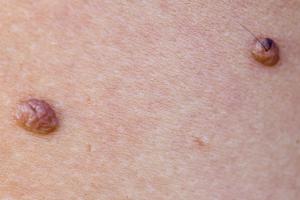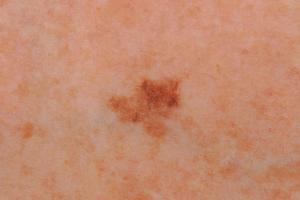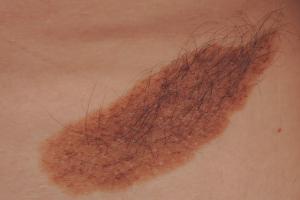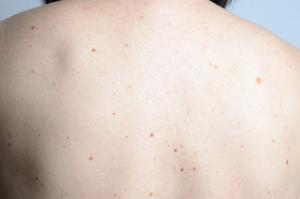Moles
Moles are small coloured spots on the skin made up of cells called melanocytes. These produce the colour (pigment) in your skin. Some moles are present at birth, although most develop during the first 30 years of life.
About moles
Moles can change in number and appearance. Some fade away over time, often without you realising. They also sometimes respond to hormonal changes, for example during:
- pregnancy – when they may get slightly darker
- teenage years – when they increase in number
- older age – when they may disappear from 40 to 50 years of age onwards
Types of moles
There are many different types of moles. Moles can vary significantly in appearance.
For example:
- the colour can be pink, red, blue or varied shades from light to dark brown
- they can be flat or raised, hairless or hairy
- they can be round, oval or irregular
- they can have several shades of brown in the same mole



When and why moles develop
Some moles are present at birth, although most develop during the first 30 years of life. People with fair skin often have more moles than people with darker skin.
You are more likely to develop lots of moles, or a certain type of mole, if they are common in your family.

Where you were brought up may also make a difference, for example, if you have spent a lot of time in the sun, you may have a lot of small moles.
Harmless moles
Most moles are harmless. However, they may change over time, and some may become harmful.
Moles can also be a nuisance, for example, if they regularly catch on your clothing or you cut them while shaving.
These moles can be surgically treated. Speak to your GP if you have a mole that is causing you problems.
If you do not like the appearance of a mole for cosmetic reasons, you will usually have to pay for cosmetic mole treatment. This treatment is often carried out at a private clinic. Ask your GP for advice about where to get treatment.
Checking your skin
You should check your skin every few months for any:
- new moles that develop (particularly after your teenage years, when new moles become less common)
- changes to existing moles
A mole can change in weeks or months.
Things to look for include:
- moles with uneven colouring – most moles only have one or two colours, many (but not all) melanomas have lots of different shades (see section on cancerous moles below)
- moles with an uneven or ragged edge – moles are usually (but not always) circular or oval with a smooth border
- bleeding, itching, red, inflamed (swollen), oozing or crusty moles
- moles that get a lot bigger (greater than six mm) – most moles are no bigger than the width of a pencil
A helpful way to remember what to look for is to use the ABCDE method. The ABCDE checklist has been developed to help people to tell the difference between a normal mole and a melanoma.
A – asymmetry
B – border irregularity
C – colour change
D – diameter (greater than six mm)
E – elevated (raised) or enlarged
Suspicious moles like this can occur anywhere on your body, but most happen on the back, legs, arms and face. These are the areas of the body most commonly exposed to the sun.
If you notice any changes to your moles or are worried about them, see your GP. Changes to a mole may be an early indication of a type of skin cancer called melanoma.
Cancerous moles
While most moles are benign (non-cancerous), in rare cases they can develop into melanoma. Melanoma is a serious and aggressive form of skin cancer.
Melanomas usually appear:
- as a dark, fast-growing spot where there was not one before
or
- a pre-existing mole that changes size, shape or colour and bleeds, itches or reddens
The main treatment for melanoma is surgery. Your treatment will depend on how much the melanoma has grown and where it is.
If melanoma is diagnosed and treated at an early stage, surgery is usually successful. It's important if you have a suspicious mole that you go to have it checked out. You may need follow-up care to prevent melanoma recurring.
Preventing cancerous moles
If you have a lot of moles, it’s important to take extra care in the sun. Although it’s not always possible to prevent melanoma, avoiding overexposure to UV light can reduce your chances of developing it.
You can help protect yourself from sun damage if you:
- stay in the shade when the sun is at its strongest (between 11.00 am and 3.00 pm)
- cover up with clothes, a wide-brimmed hat and sunglasses
- use a high factor sunscreen (minimum SPF 30) and reapply it regularly, particularly after swimming
- avoid using sunlamps or sunbeds because they give out UV rays
Other blemishes
Seborrhoeic keratoses
Seborrhoeic keratoses look like raised warts. They can be skin-coloured, black, dirty-yellowish or a grey-brown colour. They most often develop on the chest and tummy and are common in older people.
Freckles
Freckles are small, flat brown marks that often appear on the face or areas exposed to the sun. They are caused by an increased amount of melanin, the pigment that gives your skin colour.
Sun spots (solar lentigines)
Sun spots (solar lentigines) are brown marks on the skin, especially the face and arms, which can develop on people who spend a great amount of time in the sun. These tend to appear later in life.
More useful links
- How to use your health services
- Protection from the sun
- Skin Cancer Information and Sun Protection Advice - Cancer Research UK website
- Skin cancer
The information on this page has been adapted from original content from the NHS website.
For further information see terms and conditions.